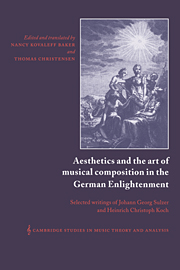 Aesthetics and the Art of Musical Composition in the German Enlightenment
Aesthetics and the Art of Musical Composition in the German Enlightenment Book contents
- Frontmatter
- Contents
- Foreword by Ian Bent
- PART I JOHANN GEORG SULZER GENERAL THEORY OF THE FINE ARTS (1771–74): SELECTED ARTICLES
- Introduction by Thomas Christensen
- I Aesthetic foundations
- II The creative process
- III Musical issues
- PART II HEINRICH CHRISTOPH KOCH INTRODUCTORY ESSAY ON COMPOSITION, VOL. II (1787)
- Index
Introduction by Thomas Christensen
Published online by Cambridge University Press: 30 September 2009
- Frontmatter
- Contents
- Foreword by Ian Bent
- PART I JOHANN GEORG SULZER GENERAL THEORY OF THE FINE ARTS (1771–74): SELECTED ARTICLES
- Introduction by Thomas Christensen
- I Aesthetic foundations
- II The creative process
- III Musical issues
- PART II HEINRICH CHRISTOPH KOCH INTRODUCTORY ESSAY ON COMPOSITION, VOL. II (1787)
- Index
Summary
“Can genius suffer to be shackled and imprisoned by rules?” the architectural theorist Charles Briseux worried in 1752. “Would it not suffocate its fire to fix limits to the sphere of its activity?” Goethe was treating much the same question when he narrated the tragic struggle of the impetuous young Werther, who tried in vain to tame the fires of his heart's passions within the unyielding confines of society's moeurs. The tension both Briseux and Goethe addressed was a critical one in the self-proclaimed age of Enlightenment: How does the artist reconcile the competing demands of imagination and reason? To what degree can the artist submit to the more volatile forces of inspiration and passion while the art work itself remains bound to the rules of propriety and convention? To be sure, these were not questions posed only in the eighteenth century. Since Plato's criticisms directed to the Rhapsodes in his dialogue Ion, one of the central problems in Western philosophical aesthetics – or, as it was more commonly called before Alexander Baumgarten coined the term “aesthetics” in 1750, “poetics” – has always concerned the fixing of artistic boundaries, reconciling the Dionysian urge for expression and originality with an Apollonian demand for order and control.
- Type
- Chapter
- Information
- Aesthetics and the Art of Musical Composition in the German EnlightenmentSelected Writings of Johann Georg Sulzer and Heinrich Christoph Koch, pp. 3 - 24Publisher: Cambridge University PressPrint publication year: 1996


